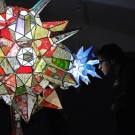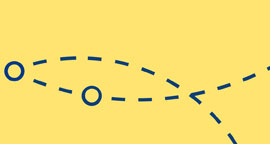Centre for Contemporary Culture at Palazzo Strozzi
Palazzo Strozzi
Kirsten Hassenfeld

Kirsten Hassenfeld’s works use a commonplace material like recycled gift-wrapping paper to create hanging sculptures, set at the evanescent boundary between the enigmatic and the domestic.
Warning: A non-numeric value encountered in /var/www/vhosts/strozzina.org/httpdocs/admin/wp-content/plugins/lightbox-gallery/lightbox-gallery.php on line 443
- Exhibition view "American Dreamers", CCC Strozzina, Palazzo Strozzi, Firenze
Kirsten Hassenfeld, Varoius works, Courtesy l’artista e / the artist and Peter Mendenhall Gallery, Los Angeles (foto Martino Margheri)
- Exhibition view "American Dreamers", CCC Strozzina, Palazzo Strozzi, Firenze
Kirsten Hassenfeld, Star Upon Star, 2011, Carta e materiali vari / Paper with mixed media Another Star, 2011, Carta e materiali vari / Paper with mixed media Tutte le opere / All the works: Courtesy l’artista e / the artist and Peter Mendenhall Gallery, Los Angeles (foto Martino Margheri)
- Exhibition view "American Dreamers", CCC Strozzina, Palazzo Strozzi, Firenze
Kirsten Hassenfeld, Star Upon Star, 2011, Carta e materiali vari / Paper with mixed media Blue Star, 2011, Carta e materiali vari / Paper with mixed media. Prodotta da / Produced by CCC Strozzina, Fondazione Palazzo Strozzi Tutte le opere / All the works: Courtesy l’artista e / the artist and Peter Mendenhall Gallery, Los Angeles (foto Martino Margheri)
- Exhibition view "American Dreamers", CCC Strozzina, Palazzo Strozzi, Firenze
Kirsten Hassenfeld, Various works Tutte le opere / All the works: Courtesy l’artista e / the artist and Peter Mendenhall Gallery, Los Angeles (foto Martino Margheri)
- Exhibition view "American Dreamers", CCC Strozzina, Palazzo Strozzi, Firenze
Kirsten Hassenfeld, Star Upon Star, 2011 Carta e materiali vari / Paper with mixed media Tutte le opere / All the works: Courtesy l’artista e / the artist and Peter Mendenhall Gallery, Los Angeles (foto Martino Margheri)
Kirsten Hassenfeld begins her works by experimenting with the material she uses where her skill reflects the revival of traditional craft techniques. She manually hand-cuts pieces of paper, rolls and coils them to assemble the tens of thousands of tiny, fragile components that comprise each of her works. In the Star series, Hassenfeld creates translucent objects that are exhibited as hanging light sculptures, where each one is made out of ordinary material like generic giftwrapping paper.
Hassenfeld’s personal skill and vision transmute the constructed shapes into art objects. Her work is an example of the new ornamentalism found in contemporary art, which has seen a resurgence in the United States over the last decade and directly challenges the hierarchy between the decorative and fine arts. For this series, the artist works with recycled material and discarded objects found in thrift stores or off the street. In reusing bits of wrapping paper, she infuses her works with an idea of fragility, while at the same time refers to the concept of gifting, playing on the possibility to transform discarded material into something new, in the form of a gift with precious value. Hassenfeld draws a direct parallel to the idea of the artist as a giver of gifts and the viewer as a charmed recipient. Her work triggers a reflection on the human condition and on being in a state of desire, not simply for material objects but also yearnings for greater existential answers.
As she says: “When I was in Brooklyn, I lived in an area where there were a lot of pawnshops, and that was hugely influential on my thinking. I started making these environments that were about abundance and splendor, but almost in a generic way about the shape of the gem form, the universally understood symbol for treasure. Everybody usually wants what that they don’t have, and sometimes it’s not a material thing and sometimes it is.”
Kirsten Hassenfeld (1971, Albany, NY, USA; lives and works in New York) studied at the University of Arizona, Tucson and the Rhode Island School of Design, Providence. Her translucent sculptures are characterized by an hand-made originality. Since 1999 she has been using ordinary material like paper to create elaborate works where she expresses his obsession for highly detailed constructions. She has been awarded with prestigious acknowledgments like the Individual Artist Grant, New York Foundation for Arts and the Percent for Art Commission of the Department of Cultural Affairs, New York (both in 2009). Her work has been included in numerous prestigious group exhibitions at locations such as MoMA PS1, the Brooklyn Museum of Art, White Columns and an exhibition organized by the Public Art Fund in Brooklyn. She has received grants from The Pollock-Krasner Foundation, Dieu Donne Papermill and The Marie Walsh Sharpe Foundation. Her recent solo shows include: (2007) Dans La Lune, Rice Gallery, Rice University, Houston, TX; (2009) Smack Mellon Gallery, Brooklyn, NY; Cade Tompkins Edition&Project, Providence, RI; David Winton Bell Gallery, List Art Center, Brown University, Providence, RI; (2010) Institute of Contemporary Art, Maine College of Art, Portland, OR; Esther Massry Gallery and College of St. Rose, Albany, OR.











